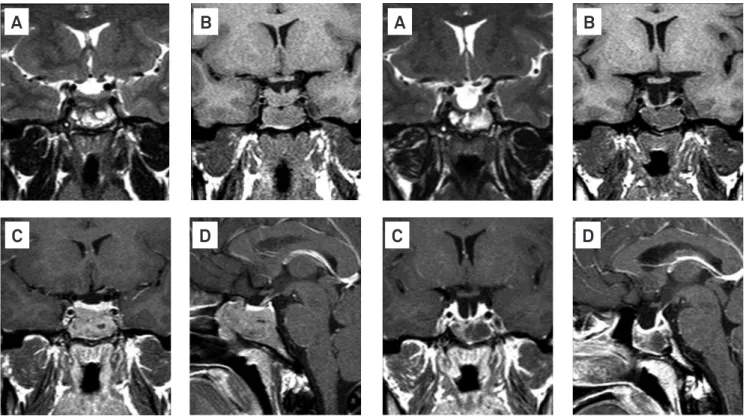744
LETTERS
Ectopic growth hormone-secreting pituitary
adenoma involving the clivus treated with
octreotide: role of magnetic resonance
imaging in the diagnosis and clinical follow-up
Adenoma hipofisário ectópico secretor de hormônio de crescimento envolvendo o clivus
tratado com octreotide: papel da ressonância magnética no diagnóstico e seguimento clínico
José Roberto L. Ferraz-Filho1, Ulysses S. Torres1, Augusto César V. Teixeira1, Maria Laura S. Castro1,
Marco Antonio F. Dias2
1Department of Radiology of Hospital de Base, São José do Rio Preto Medical School, São José do Rio Preto SP, Brazil; 2Department of Endocrinology of Hospital de Base, São José do Rio Preto Medical School, São José do Rio Preto SP, Brazil.
Correspondence: José Roberto L. Ferraz-Filho; São José do Rio Preto Medical School; Department of Radiology; Avenida Brigadeiro Faria Lima 5.544; 15090-000 São José do Rio Preto SP - Brasil; E-mail: jrl.ferraz@terra.com.br
Conflict of interest: There is no conflict of interest to declare.
Received 29 March 2012; Received in final form 30 April 2012; Accepted 07 May 2012
Ectopic pituitary adenomas (EPAs) are rare neoplasms, mainly described in the sphenoid sinus (SS) and suprasel-lar region; hormone-secreting EPAs with clival involve-ment have been rarely reported. We describe a case of a pharmacologically treated GH-secreting EPA involving the clivus and SS, with satisfactory clinical outcome and tu-mor size reduction. As transsphenoidal resection is the standard approach, post-treatment imaging findings in the nonsurgical management of this entity, to our knowl-edge, have not been reported before.
CASE REPORT
A 30-year-old woman presented with clinical signs and symptoms of acromegaly for the past one year. A hormonal proile conirmed acromegaly [plasma IGF-1 level >500 ng/mL (94–309 ng/mL), GH=218 ng/mL (<5 ng/mL) and prolac-tin=7 ng/mL (3–29 ng/mL)]; an oral glucose tolerance test revealed no suppression of GH values. With suspi-cion of a pituitary adenoma, a brain MRI was performed, which revealed, however, a 3.0 x 2.0 cm enhancing mass lesion on both T1- and T2-weighted images involving the clivus and SS, well demarcated from the normal pituitary, which was cranially displaced (Fig 1). After a careful ex-clusion of other rare causes of acromegaly, association of clinical, laboratorial and imaging findings were consis-tent with a GH-secreting EPA.
Despite appropriate medical counseling, the patient refused surgical treatment. herefore, pharmacological
treatment with octreotide, a somastotatin analogue, was indicated in association with a close follow-up. he patient presented stabilization of IGF-1 levels and random measure-ments of GH showed safe levels <2.0 μg/L, conirming an ad-equate response1,2. Annual control MRI scans demonstrated
a progressive tumor shrinkage with heterogeneous enhance-ment (probably indicating areas of necrosis) (Fig 2). he pa-tient remains well and asymptomatic after three years of fol-low-up, still under pharmacological treatment.
DISCUSSION
EPAs arise from the extrasellar region without any in-volvement of the normal pituitary gland in the sella tur-cica3. It has been suggested that EPAs could arise along
the cranial migration route of Rathke’s pouch toward the hypothalamus, after its development as an invagination of the primitive oral cavity during the third week of ges-tation; remnants of this pharyngopituitary canal in bone areas, for example, could explain EPAs in the clivus or sphenoid bone4,5.
Surgical resection of the adenoma causing acromegaly has been the traditional approach, although normalization of IGF-1 and GH levels is observed in only 40–70% of patients1.
Although octreotide is not currently recommended as a pri-mary therapy (except when surgical treatment cannot be per-formed)6, in several trials it has demonstrated to be as
efec-tive as surgery regarding the control of IGF-1 and GH levels, also inducing tumor shrinkage6.
745
LETTERS
In our case, cross-sectional imaging played a pivotal role in the diagnosis, despite the absence of a confirma-tory histopathological study. With effect, pituitary adeno-mas can be classified on the basis of excessive hormonal secretion7. Subsequently, MRI contributed in the clinical Fig 1. T2- and T1-W pre-contrast coronal images (A and B) demonstrate a heterogeneous mass lesion containing cystic areas involving the clivus and sphenoidal sinus; post-contrast T1-W coronal (C) and sagittal images (D) show a homogeneous enhancement of the lesion, without evidence of involvement of the normal hypophyseal parenchyma.
A
B
D
C
Fig 2. T2- and T1-W pre-contrast coronal images (A and B) obtained at the third year of follow-up demonstrate tumor size reduction; post-contrast T1-W coronal (C) and sagittal images (D) show a heterogeneous enhancement of the lesion, probably secondary to areas of necrosis, with reduction of the hypophyseal parenchymal thickness and partial filling of the sella turcica with cerebrospinal fluid (empty sella).
A
B
D
C
follow-up by evaluating tumoral response to pharmaco-logical treatment. Finally, the good clinical response fortu-nately obtained and principally the tumor shrinkage after specific treatment with a somatostatin analogue favored our initial diagnosis.
1. Chanson P, Salenave S, Kamenicky P, Cazabat L, Young J. Pituitary tumours: acromegaly. Best Pract Res Clin Endocrinol Metab 2009;23:555-574.
2. Giustina A, Chanson P, Bronstein MD, et al. A consensus on criteria for cure of acromegaly. J Clin Endocrinol Metab 2010; 95:3141-3148.
3. Pasquini E, Faustini-Fustini M, Sciarretta V, et al. Ectopic TSH-secreting pituitary adenoma of the vomerosphenoidal junction. Eur J Endocrinol 2003;148:253-257.
4. Hou L, Harshbarger T, Herrick MK, Tse V. Suprasellar adrenocorticotropic hormone-secreting ectopic pituitary adenoma: case report and literature review. Neurosurgery 2002;50:618-625.
5. Casselman JW. The skull base: tumoral lesions. Eur Radiol 2005; 15:534-542.
6. Yang LP, Keating GM. Octreotide long-acting release (LAR): a review of its use in the management of acromegaly. Drugs 2010;70:1745-1769.
7. Pickett CA. Update on the medical management of pituitary adenomas. Curr Neurol Neurosci Rep 2005;5:178-185.
References
